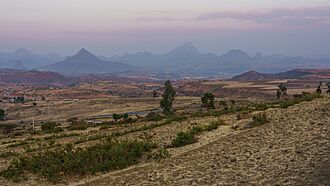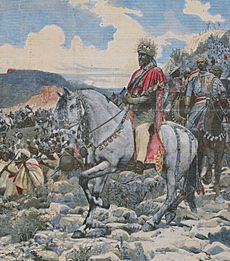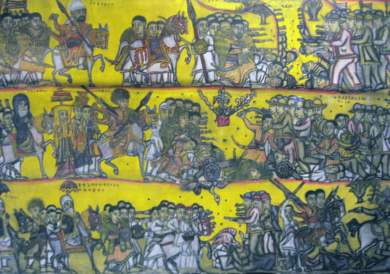Battle of Adwa facts for kids
Quick facts for kids Battle of Adwa |
|||||||
|---|---|---|---|---|---|---|---|
| Part of the First Italo-Ethiopian War | |||||||
 British illustration of "Dabormida's last rally" |
|||||||
|
|||||||
| Belligerents | |||||||
| Commanders and leaders | |||||||
| Strength | |||||||
| 73,000–100,000 | 14,519–17,770 | ||||||
| Casualties and losses | |||||||
| 3,886–7,000 killed | ~6,000 killed 3,865 captured |
||||||
The Battle of Adwa (Amharic: የዐድዋ ጦርነት; Tigrinya: ውግእ ዓድዋ; Italian: battaglia di Adua) was a very important battle in the First Italo-Ethiopian War. It happened on Sunday, March 1, 1896, near the town of Adwa in Ethiopia. Ethiopia won a huge victory against the Italian army, which was led by General Oreste Baratieri.
This big win stopped Italy from expanding its colonial empire in Africa. By the late 1800s, most of Africa had been taken over by European powers. Only Ethiopia and Liberia remained independent. The Battle of Adwa became a powerful symbol of pan-Africanism, showing that African nations could fight for their freedom. It also kept Ethiopia independent until the Second Italo-Ethiopian War happened about forty years later.
Contents
Why the Battle Happened
In 1889, Italy signed a deal called the Treaty of Wuchale with King Menelik of Shewa. This treaty was made after Italy took control of Eritrea. It recognized Italy's claim over this coastal area. Italy also promised to give Ethiopia money and military supplies.
However, there was a big disagreement about one part of the treaty. The Italian version said that the Emperor of Ethiopia had to handle all foreign affairs through Italian officials. This would have made Ethiopia a protectorate of Italy, meaning Italy would control its foreign policy. But the Amharic (Ethiopian) version said the Emperor could use Italy's help if he wanted to. Italian diplomats claimed Menelik knew about the difference.
Because of this disagreement, the Italian government decided to use force. They wanted Ethiopia to follow the Italian version of the treaty. This led to the First Italo-Ethiopian War.
Early Fights and Italian Advance
In December 1894, a man named Bahta Hagos led a rebellion against the Italians in Eritrea. Italian forces, led by Major Pietro Toselli, quickly stopped the rebellion and killed Bahta. In January 1895, General Oreste Baratieri's army defeated Ras Mengesha Yohannes at the Battle of Coatit. This forced Mengesha to retreat.
By late 1895, Italian troops had moved deep into Ethiopia. They took control of much of the Tigray region. On December 7, 1895, a larger Ethiopian force destroyed a small Italian unit at the Battle of Amba Alagi. This forced the Italians to pull back to stronger positions in Tigray.
By February 1896, both armies were running low on supplies. General Baratieri, the Italian commander, knew that the Ethiopian army was living off the land. He thought that if supplies ran out, Emperor Menelik II's army would start to break apart. However, the Italian government pushed Baratieri to attack.
On the evening of February 29, Baratieri met with his generals. He told them that they would run out of food in less than five days. He suggested retreating, maybe all the way back to Asmara. But his generals strongly argued for an attack. They believed retreating would make their soldiers feel even worse. One general, Dabormida, said Italy would rather lose many men than retreat dishonorably. Baratieri finally decided to attack the next morning at 9:00 AM. His troops started marching to their positions shortly after midnight.
Who Fought in the Battle
The Battle of Adwa involved a large number of soldiers from both sides.
Ethiopian Army
The Ethiopian forces were made up of different armies led by powerful leaders. Emperor Menelik II led the main army. His wife, Empress Taytu Betul, also commanded her own troops. Other important leaders included:
- Negus Tekle Haymanot of Gojjam from Gojjam
- Ras Makonnen Wolde Mikael from Harar
- Ras Mengesha Yohannes and Ras Alula from Tigray
- Ras Mikael of Wollo from Wollo
The total number of Ethiopian fighters was estimated to be between 73,000 and over 100,000. This meant they outnumbered the Italians by about five times. Most of the army had rifles, but there were also many cavalry (soldiers on horseback) and infantry (foot soldiers) armed with spears. Many people who followed the army also helped by providing food and supplies.
Italian Army
The Italian army had about 14,500 to 17,770 combat troops. They also had 56 artillery cannons. One part of their army was made up of Eritrean Ascari, who were Eritrean soldiers led by Italian officers. The rest were Italian units.
Many of the Italian soldiers were new recruits who had just arrived from Italy. They were not very experienced. The Italian army also faced several problems:
- They had bad maps.
- Their guns were old models.
- They had poor communication equipment.
- Their shoes were not good for the rocky ground.
- Soldiers' morale was low.
General Oreste Baratieri was in charge of the Italian forces.
The Battle Begins
On the night of February 29 and early morning of March 1, three Italian brigades marched separately towards Adwa. A fourth brigade stayed in camp. The Italian plan was for three groups to march side-by-side to the tops of three mountains. This would give them a high position to fight the Ethiopians.
However, the Italian brigades got separated during their night march. By dawn, they were spread out over several miles of difficult land. Their maps were not good. General Albertone, who was supposed to set the pace, mistook one mountain for another. When a scout told him his mistake, Albertone marched directly into where the Ethiopians were waiting.
Emperor Menelik already knew the Italians were advancing. His spies, sent by Ras Alula, brought him the news. The Emperor had planned to move his camp the next day, March 2. He had woken up early to pray when he heard the news.
The Emperor quickly gathered the armies of his nobles. With Empress Taytu Betul by his side, he ordered his forces to attack. The Ethiopian forces took positions on the hills overlooking the Adwa valley. This was a perfect spot to meet the Italians, who were out in the open and easy targets.
First Clashes
Albertone's Eritrean Ascari Brigade was the first to meet the Ethiopians at 6:00 AM. The Ethiopian units closest to Albertone's position attacked first. These were the Tigray army, led by Ras Mengesha and Ras Alula. Soon, troops from Negus Tekle Haymanot, Ras Makonnen, and Ras Mikael joined the fight. A large part of the Ethiopian army quickly focused on Albertone's isolated brigade.
At first, Italian artillery caused many casualties for the Ethiopians. But then, a group of Ethiopians, led by Balcha Safo, brought their quick-firing guns to a lower part of Mount Abba Gerima. This removed the Italian advantage in artillery. Albertone's soldiers, who were greatly outnumbered, held their ground for two hours. But eventually, Albertone surrendered. The remaining soldiers fled to Arimondi's brigade.
Arimondi's brigade fought back against the Ethiopian armies for three hours. But Menelik then sent in his reserve force of 25,000 soldiers. They quickly overwhelmed the Italian defenders. Arimondi's brigade broke and ran. The officers and a few soldiers who stayed were quickly defeated.
General Baratieri realized the battle was lost. He ordered a general retreat. He tried to get the last Italian reserve units, led by General Ellena, to cover the retreat. But before they could get into position, their lines were broken by a flood of fleeing Italian soldiers. The reserve force had no chance to form a defense and was defeated within minutes. By noon, the Italian center was completely broken. Ethiopian cavalry chased the fleeing Italians. General Arimondi and almost all his officers were killed.
Dabormida's Italian Brigade had tried to help Albertone but couldn't reach him in time. Dabormida was cut off from the rest of the Italian army and didn't know that the other Italian troops had been destroyed. The Ethiopians, who had just defeated Arimondi's and Ellena's brigades, now moved to surround Dabormida's brigade from behind. By 3:00 PM, Dabormida tried to break out of the encirclement and retreat. However, he accidentally led his troops into a narrow valley. There, the Wollo Oromo cavalry, led by Ras Mikael, destroyed his brigade. Dabormida's body was never found.
The retreating Italian columns were chased for nine miles. Then, the Ethiopian cavalry stopped. Fires were lit on hilltops to tell local farmers to attack any Italian soldiers who were left behind. Baratieri's defeated army continued to retreat all night. They crossed the Belessa River and reached Italian Eritrea by March 4. Back on the battlefield, the Ethiopians were celebrating their victory.
What Happened Right After
The Battle of Adwa was a huge loss for Italy. About 6,100 Italian soldiers were killed, and 1,428 were wounded. In addition, 1,865 Italians and 2,000 Eritrean soldiers were captured. Ethiopian losses were estimated to be around 3,886 killed and 6,000 wounded. The Italians left behind all their artillery, 11,000 rifles, and most of their supplies.
The Italian prisoners were generally treated well by the Ethiopians. General Albertone, for example, was given a tent, a horse, and servants. However, about 70 Italian prisoners were killed in revenge for the death of an Ethiopian officer. The officer responsible for this was reportedly put in prison by Menelik.
News of the defeat caused outrage in Italy. There were street protests in many major cities. Universities and theaters were closed in Rome to prevent violence. The Prime Minister, Crispi, resigned. People called for all military forces to return from Africa. Families shared letters from soldiers describing their poor conditions and fears. King Umberto declared his birthday a day of mourning.
Long-Term Effects
Emperor Menelik decided not to chase the Italians out of their colony completely. He only demanded that the Treaty of Wuchale be cancelled. His main goal was to keep Ethiopia independent. Also, Ethiopia had just gone through a long famine, and the army was tired and low on food.
As a direct result of the battle, Italy signed the Treaty of Addis Ababa. This treaty officially recognized Ethiopia as an independent state.
Almost forty years later, on October 3, 1935, Italy launched a new military campaign. This was the Second Italo-Ethiopian War, led by Benito Mussolini. This time, the Italians used much more advanced military technology, like tanks and aircraft, and even chemical weapons. Ethiopian forces were defeated by May 1936. Italy then occupied Ethiopia for five years (1936–41). They were eventually driven out during World War II by British forces and Ethiopian freedom fighters.
Why Adwa is Important
The Battle of Adwa was a major turning point in Ethiopian history. It brought Ethiopia to the world's attention.
This defeat of a European colonial power and the recognition of an African nation's independence became a source of inspiration. It encouraged African nationalists during their fight for freedom from colonial rule. It also inspired activists and leaders of the Pan-African movement.
After the victory in 1896, Ethiopia became very important to Africans and black people around the world. It was the only African state that successfully defeated a European colonial power in a direct battle. Italy, which had seen Ethiopians as an inferior race, was forced to recognize Ethiopia as an equal. Adwa became a symbol of African bravery and resistance. It gave hope to thousands of Africans who were suffering under European rule. It also inspired a strong sense of Pan-Africanism among people of African descent who had faced terrible injustices.
For Italy, Adwa was a big humiliation. Some historians believe this defeat contributed to the rise of Fascism in Italy. Leaders like Mussolini wanted to "avenge" the defeat. When Italian troops occupied Addis Ababa in May 1936, Mussolini famously declared, "Adua è vendicata" (Adwa has been avenged).
The victory also encouraged some conservative ideas in Ethiopia. It strengthened those who wanted to keep Ethiopia from adopting Western ways. Both Emperor Menelik and later Haile Selassie had to deal with this resistance.
Celebrating Adwa Today
Public Holiday
Adwa Victory Day is a public holiday across all of Ethiopia. Schools, banks, post offices, and government offices are closed. Shops are usually open but close earlier than usual.
Public Celebrations
The Victory of Adwa is celebrated in public places. In Addis Ababa, the capital, celebrations happen at Menelik Square. Government officials, patriots, foreign diplomats, and the general public attend. The Ethiopian Police Orchestra plays patriotic songs.
People dress up in traditional Ethiopian patriotic clothes. Men often wear special trousers and vests. They carry the Ethiopian flag and banners, as well as traditional Ethiopian shields and swords. Women wear beautiful handcrafted traditional Ethiopian clothing, called Habesha kemis. Some wear royal crowns. Women's clothing styles often copy the traditional styles of Ethiopian patriotic women. Empress Taytu Betul is especially remembered during these celebrations.
Empress Taytu Betul, Emperor Menelik II's wife, played a very important role in the Battle of Adwa. Thousands of women participated in the battle. Some were trained as nurses for the wounded. Others cooked and supplied food and water to the soldiers.
Besides Addis Ababa, other major cities in Ethiopia, like Bahir Dar, Debre Markos, and the town of Adwa itself, also celebrate the victory with public ceremonies.
Symbols of Victory
Many images and symbols are used to remember the Victory of Adwa. These include the green, gold, and red Ethiopian flag. Pictures of Emperor Menelik II and Empress Taytu Betul are common. Other important leaders like King Tekle Haymanot, King Michael of Wollo, and Balcha Safo are also honored.
Older people who fought in battles wear their medals. Young people often wear T-shirts with images of Emperor Menelik II, Empress Taytu, and Emperor Haile Selassie. Popular patriotic songs are played. Two famous songs are Ejigayehu Shibabaw's song about Adwa and Teddy Afro's popular song "Tikur Sew" (meaning "black man" or "black person"). This song refers to Emperor Menelik II's important African victory over Europeans.
See also
- Scramble for Africa
- Colonisation of Africa
- Adwa Zero KM Project






